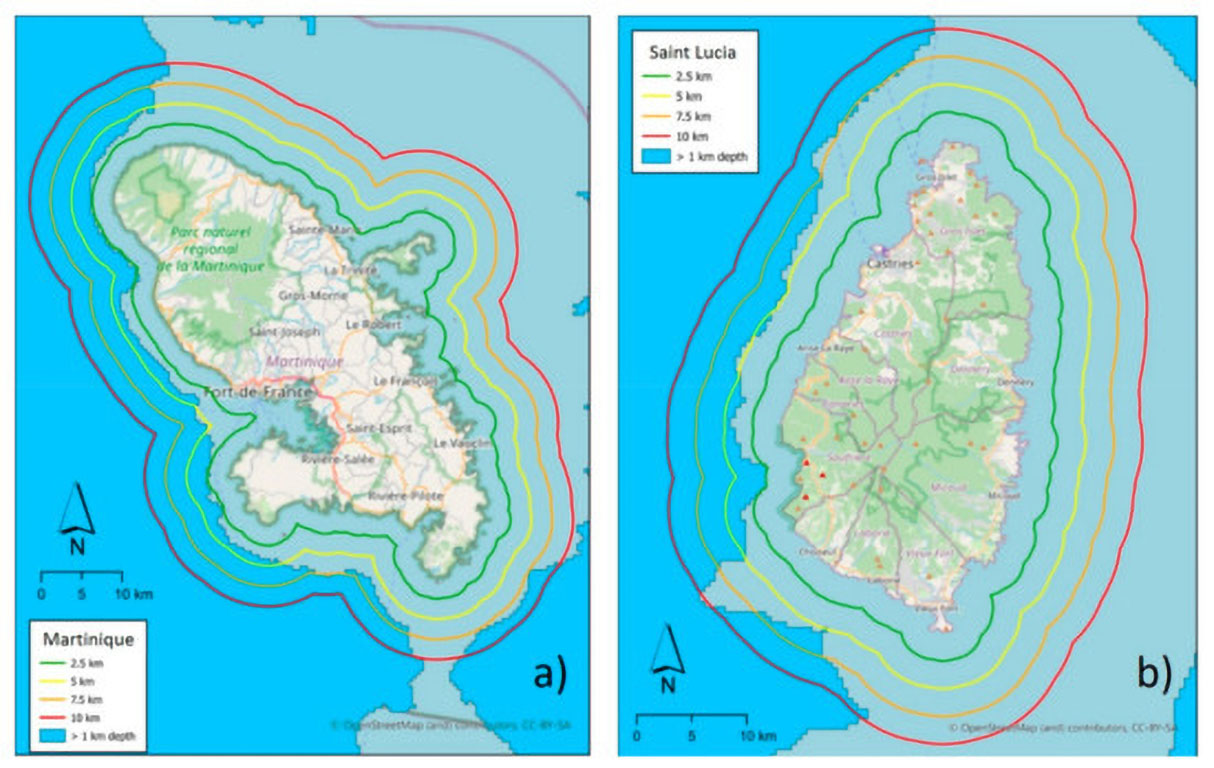Hanley Sustainability Institute

HSI staffers’ paper explores Caribbean Islands’ potential use of ocean thermal energy conversion
By Mark Gokavi
Note: University of Dayton professor Robert Brecha, who has been a member of UD’s Department of Physics since 1993, taught sustainability courses before a sabbatical and then a two-year appointment as a European Union Marie Curie fellow with Berlin-based Climate Analytics. He is returning to campus in fall 2021 as a tenured professor of sustainability for the Hanley Sustainability Institute.
Two University of Dayton sustainability experts worked on a paper on ocean thermal energy conversion (OTEC) highlighted in a Climate Analytics blog post.
University of Dayton professor Bob Brecha and three others wrote the paper that addressed Geographic Information System (GIS) mapping of the Caribbean islands, the potential for near-coastal deep-water as a resource for OTEC, and an estimate of where OTEC could be advantageous.
One of the other authors is Katie Schoenenberger, until recently the director of student engagement at the Hanley Sustainability Institute. Schoenenberger’s title is now director of GIS management and environmental sustainability project development - a joint position between UD's College of Arts and Sciences and Facilities Management. The other authors are Masaō Ashtine and Randy Koon Koon.
The authors wrote OTEC is the process of extracting energy from the difference in temperature between surface and deep water, a concept first proposed in the 1880s. The first working power plant using this technology was built in Cuba in 1930, with additional demonstration units built later.
“We have used Geographical Information Systems (GIS) tools to determine where water depth and proximity to shore could provide a site for ocean thermal energy conversion installation for all islands in the Caribbean,” the post said. “But this technology is still the poor cousin in the renewables family, leading many to ask – what is ocean thermal energy conversion and what can it bring to the table to support a 100% renewable electricity system?”
The post also points out that Small Island Developing States (SIDS) in the Caribbean are bathed in sunshine and wind and surrounded by the ocean, but that their electricity systems are dominated by imported diesel fuel.
“Many Caribbean island nations have historically been heavily dependent on imported fossil fuels for both power and transportation, while at the same time being at an enhanced risk from the impacts of climate change, although their emissions represent a very tiny fraction of the global total responsible for climate change,” the paper’s abstract states. “SIDSs are among the leaders in advocating for the ambitious 1.5 °C Paris Agreement target and the transition to 100% sustainable, renewable energy systems.”
In the paper, hourly data were utilized to show the trade-offs between battery storage needs and dispatchable renewable sources such as OTEC in 100% renewable electricity systems in technological and economic terms.
One key point made in the paper is near-shore, open-cycle OTEC with accompanying desalination can enable a higher penetration of renewable energy and lead to lower system levelized costs than those of a conventional fossil fuel system.
“The integration of variable renewable energy, like solar and wind, requires controllable (‘dispatchable’) sources of power. Or to be able to store energy. Or both,” the paper said. “Although battery storage has become much cheaper in recent years, maintaining system reliability is easier if there is also some other source of flexible power generation like hydropower, biomass and waste for electricity, geothermal power, wave and tidal energy – and OTEC.”
The authors write OTEC hasn’t caught on yet because of relatively high costs and the limitation it can only be implemented in regions where there are year-round warm sea surface temperatures and cold, deep water near a shoreline. Currently there are two operating OTEC plants worldwide – in Hawaii – with more in the planning stages.
The paper also said there are proposals for sea water district cooling – where cool ocean water circulating in the system can be used to cool buildings, providing an efficient and low-cost way to tackle cooling demand without using extra electricity.
The maps above show Martinique and Saint Lucia. The Bathymetry contour (gray/blue) represents the boundary between depths of greater than and less than 1,000 meters. Other contours are equidistant from the coast at 2.5 km (green), 5.0 km (yellow), 7.5 km (orange) and 10 km (red).
